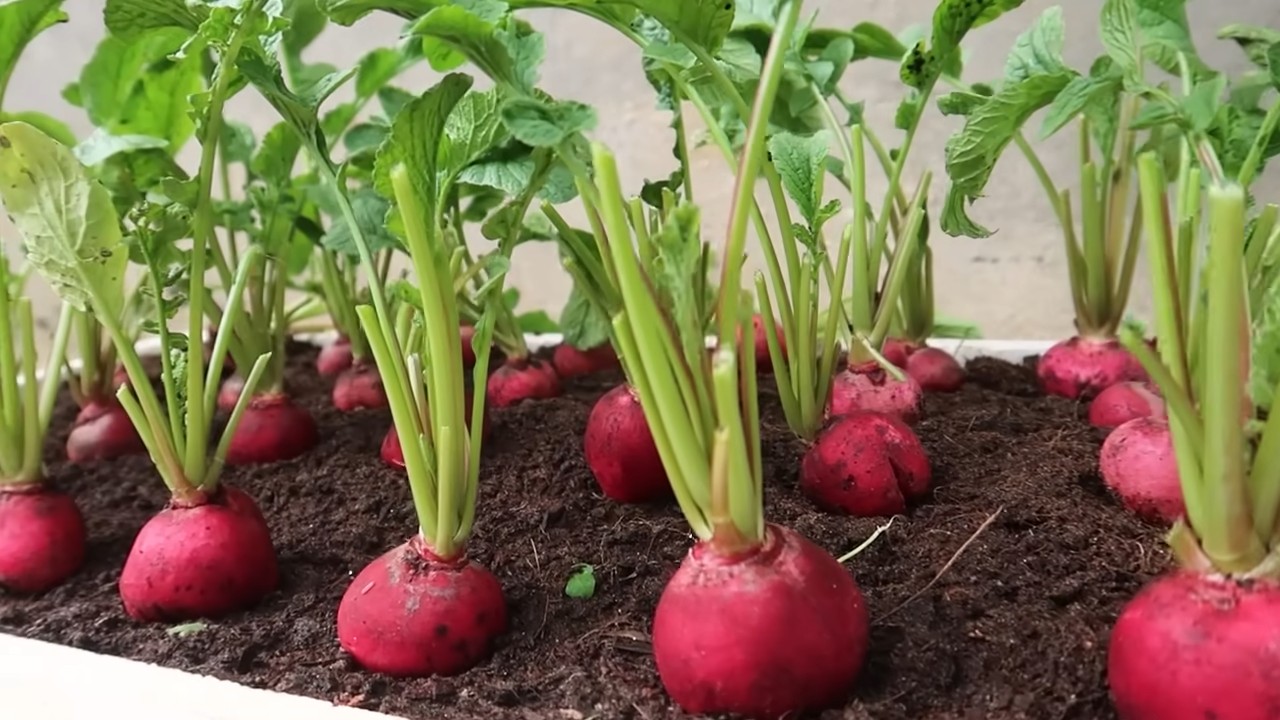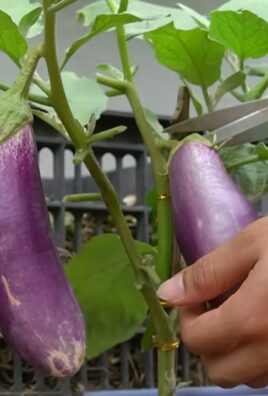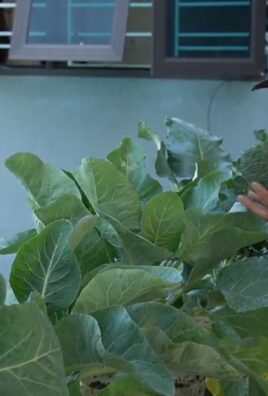Growing Radishes in Winter might sound like a gardener’s pipe dream, conjuring images of snow-dusted vegetables and frozen fingers. But I’m here to tell you it’s not only possible, but surprisingly easy and rewarding! Forget those bland, store-bought radishes – imagine biting into a crisp, peppery radish you nurtured yourself, even when the world outside is frosty.
For centuries, cultures around the globe have found ways to extend their growing seasons, relying on ingenuity and simple techniques to cultivate food year-round. From ancient Roman greenhouses to modern-day cold frames, the desire to nourish ourselves with fresh produce has driven innovation. And that’s exactly what we’re tapping into today!
Why should you bother learning these DIY tricks for growing radishes in winter? Well, for starters, it’s a fantastic way to combat the winter blues and stay connected to nature. Plus, fresh, homegrown radishes are packed with vitamins and minerals, offering a healthy boost when you need it most. But more importantly, it’s incredibly satisfying to nurture life during the dormant months. This article will provide you with simple, actionable steps to successfully grow radishes in winter, even if you’re a complete beginner. Let’s get started and bring a little springtime to your winter table!

Radieschen im Winter selbst anbauen: So geht’s!
Hey Gartenfreunde! Wer sagt, dass man im Winter nicht gärtnern kann? Ich zeige euch, wie ihr auch in der kalten Jahreszeit knackige, scharfe Radieschen ernten könnt. Es ist einfacher als ihr denkt und bringt frische Farbe und Geschmack auf den Tisch, wenn draußen alles grau ist. Los geht’s!
Was du brauchst:
* Radieschensamen (Wintersorten sind ideal, aber auch andere funktionieren)
* Anzuchterde oder hochwertige Blumenerde
* Pflanzgefäße (Töpfe, Balkonkästen, oder sogar eine alte Wanne – Hauptsache, sie haben Abzugslöcher)
* Mini-Gewächshaus oder eine durchsichtige Plastikabdeckung (optional, aber sehr empfehlenswert)
* Sprühflasche mit Wasser
* Gießkanne
* Helle Fensterbank oder Pflanzenlampe (wenn das Licht nicht ausreicht)
* Thermometer (um die Temperatur im Blick zu behalten)
Die richtige Sorte wählen:
Nicht alle Radieschen sind gleich! Für den Winteranbau eignen sich besonders Sorten, die schnell wachsen und nicht so viel Licht benötigen. Einige meiner Favoriten sind:
* ‘Raxe’: Sehr schnellwüchsig und robust.
* ‘Eiszapfen’: Mild im Geschmack und gut für den Anbau im Topf.
* ‘French Breakfast’: Klassiker mit mildem Geschmack und hübscher Form.
* ‘Sora’: Eine sehr frühe Sorte, die sich gut für den Anbau im Winter eignet.
Schritt-für-Schritt-Anleitung: Radieschen säen und pflegen
1. Vorbereitung der Pflanzgefäße:
* Zuerst reinige ich die Pflanzgefäße gründlich. Alte Erde kann Krankheiten und Schädlinge enthalten, die ich nicht in meinem Wintergarten haben möchte.
* Dann fülle ich die Gefäße mit Anzuchterde oder Blumenerde. Achte darauf, dass die Erde locker und gut durchlässig ist. Ich drücke sie leicht an, aber nicht zu fest.
* Wichtig: Lasse oben etwa 2-3 cm Platz bis zum Rand des Gefäßes. So kann ich später besser gießen, ohne dass die Erde überschwappt.
2. Aussaat der Radieschensamen:
* Ich verteile die Radieschensamen gleichmäßig auf der Erde. Der Abstand zwischen den Samen sollte etwa 2-3 cm betragen. Radieschen brauchen Platz, um sich zu entwickeln.
* Dann bedecke ich die Samen mit einer dünnen Schicht Erde (ca. 0,5 cm).
* Mit der Sprühflasche befeuchte ich die Erde vorsichtig. Sie sollte gut durchfeuchtet sein, aber nicht triefend nass.
3. Der richtige Standort:
* Radieschen brauchen Licht! Ich stelle die Pflanzgefäße an einen hellen Standort, am besten auf eine Fensterbank nach Süden.
* Wenn das Tageslicht nicht ausreicht, verwende ich eine Pflanzenlampe. Sie sollte etwa 12-14 Stunden am Tag brennen.
* Die Temperatur sollte idealerweise zwischen 15 und 20 Grad Celsius liegen. Zu hohe Temperaturen können dazu führen, dass die Radieschen schnell in die Höhe schießen und keine Knollen bilden.
4. Pflege der Radieschen:
* Gießen: Die Erde sollte immer leicht feucht sein, aber nicht nass. Ich gieße regelmäßig, aber nicht zu viel. Staunässe unbedingt vermeiden! Am besten überprüfe ich die Feuchtigkeit der Erde mit dem Finger.
* Lüften: Wenn ich ein Mini-Gewächshaus oder eine Plastikabdeckung verwende, lüfte ich regelmäßig, um Schimmelbildung zu vermeiden.
* Düngen: Radieschen brauchen nicht viel Dünger. Wenn die Blätter hellgrün werden, kann ich etwas Flüssigdünger für Gemüse verwenden. Aber Vorsicht: Zu viel Dünger kann den Geschmack beeinträchtigen.
* Ausdünnen: Wenn die Radieschen zu dicht stehen, dünne ich sie aus. Die schwächsten Pflanzen entferne ich, damit die anderen genug Platz zum Wachsen haben.
5. Schutz vor Schädlingen:
* Im Winter sind Schädlinge meist kein großes Problem, aber Blattläuse können trotzdem auftreten. Ich kontrolliere die Pflanzen regelmäßig und entferne Blattläuse gegebenenfalls mit einem feuchten Tuch oder einer milden Seifenlauge.
* Auch Trauermücken können lästig sein. Sie legen ihre Eier in die feuchte Erde. Ich lasse die Erde zwischen den Wassergaben etwas antrocknen, um die Mücken zu vertreiben. Gelbtafeln helfen auch.
Mini-Gewächshaus selber bauen (optional, aber empfehlenswert)
Ein Mini-Gewächshaus ist super, um die Radieschen vor Kälte zu schützen und die Luftfeuchtigkeit zu erhöhen. Du kannst es ganz einfach selber bauen:
1. Materialien:
* Eine durchsichtige Plastikbox oder ein alter Aquarium
* Ein paar Holzleisten oder Bambusstäbe
* Klebefilm oder Heißkleber
2. Anleitung:
* Ich messe die Größe der Plastikbox oder des Aquariums aus.
* Dann schneide ich die Holzleisten oder Bambusstäbe entsprechend zu.
* Ich klebe die Leisten oder Stäbe an den Ecken der Box oder des Aquariums fest, um eine Art Rahmen zu bilden.
* Darüber lege ich eine durchsichtige Plastikfolie oder eine alte Fensterscheibe.
* Fertig ist das Mini-Gewächshaus!
Erntezeit!
Je nach Sorte und Standort sind die Radieschen nach etwa 4-6 Wochen erntereif. Ich erkenne das daran, dass die Knollen die gewünschte Größe erreicht haben. Sie sollten fest und prall sein.
* Ernten: Ich ziehe die Radieschen vorsichtig aus der Erde. Wenn sie sich nicht leicht lösen, lockere ich die Erde etwas auf.
* Lagerung: Die Radieschen halten sich im Kühlschrank einige Tage. Ich entferne das Grün, bevor ich sie lagere, da es den Radieschen Feuchtigkeit entzieht.
Häufige Probleme und Lösungen:
* Radieschen werden nicht dick: Das kann an zu wenig Licht, zu hoher Temperatur oder zu dichtem Stand liegen. Sorge für mehr Licht, senke die Temperatur und dünne die Pflanzen aus.
* Radieschen schmecken scharf: Das kann an Wassermangel oder zu viel Sonne liegen. Gieße regelmäßig und schütze die Pflanzen vor direkter Sonneneinstrahlung.
* Radieschen schießen in die Höhe: Das kann an zu hoher Temperatur oder zu wenig Licht liegen. Sorge für kühlere Temperaturen und mehr Licht.
* Schimmelbildung: Lüfte regelmäßig und vermeide Staunässe.
Extra-Tipps für den erfolgreichen Winteranbau:
* Regelmäßig drehen: Drehe die Pflanzgefäße regelmäßig, damit die Radieschen gleichmäßig Licht bekommen und nicht schief wachsen.
* Auf die Luftfeuchtigkeit achten: Gerade im Winter ist die Luft oft sehr trocken. Stelle eine Schale mit Wasser in die Nähe der Pflanzen, um die Luftfeuchtigkeit zu erhöhen.
* Nicht aufgeben: Manchmal klappt es nicht gleich beim ersten Mal. Aber lass dich nicht entmutigen! Mit etwas Übung und Geduld wirst du bald deine eigenen Radieschen im Winter ernten können.
Radieschen-Grün nicht wegwerfen!
Das Grün der Radieschen ist viel zu schade zum Wegwerfen! Es ist reich an Vitaminen und Mineralstoffen und schmeckt lecker in Salaten, Suppen oder als Pesto. Ich verwende es auch gerne für Smoothies. Einfach mit anderen Zutaten mixen und genießen!
Fazit:
Radieschen im Winter anzubauen ist ein tolles Projekt, das Spaß macht und frische, gesunde Lebensmittel liefert. Mit den richtigen Tipps und etwas Geduld kannst auch du deine eigenen Radieschen ernten, wenn draußen Schnee liegt. Probiert es aus! Ich wünsche euch viel Erfolg und eine reiche Ernte!

Conclusion
So, there you have it! Growing radishes in winter might seem like a gardening impossibility, but with a little preparation and the right techniques, you can enjoy the crisp, peppery flavor of homegrown radishes even when the snow is falling. This DIY trick isn’t just about defying the seasons; it’s about extending your harvest, reducing your reliance on store-bought produce, and connecting with nature year-round.
Why is this a must-try? Because fresh, vibrant radishes add a delightful crunch and zest to winter salads, soups, and snacks. Imagine the satisfaction of pulling a bright red radish from the soil in the middle of January, knowing you nurtured it from seed to table. It’s a small victory against the winter blues and a testament to your gardening prowess. Plus, growing your own radishes allows you to control the growing environment, ensuring they are free from harmful pesticides and herbicides.
Consider these variations to personalize your winter radish growing experience:
* Experiment with different radish varieties: While Cherry Belle is a reliable choice, try French Breakfast for a milder flavor or Black Spanish for a more pungent kick.
* Companion planting: Plant radishes alongside carrots or lettuce in your container or raised bed. Radishes help deter pests that might bother these other vegetables.
* Succession planting: Sow a small batch of radish seeds every two weeks to ensure a continuous harvest throughout the winter months.
* Sprouts and Microgreens: If space is truly limited, consider growing radish sprouts or microgreens indoors. They are incredibly easy to grow and offer a concentrated burst of flavor and nutrients.
Don’t be intimidated by the prospect of winter gardening. Radishes are forgiving plants, and even if your first attempt isn’t perfect, you’ll learn valuable lessons along the way. The key is to provide them with adequate light, consistent moisture, and protection from extreme cold.
We wholeheartedly encourage you to give this DIY trick a try. Embrace the challenge, get your hands dirty, and experience the joy of harvesting fresh radishes in the heart of winter. And most importantly, share your experience with us! We’d love to hear about your successes, your challenges, and any tips you discover along the way. Post pictures of your winter radish harvest on social media using #WinterRadishMagic, or leave a comment below. Let’s build a community of winter gardening enthusiasts and inspire others to extend their growing season. Let us know if you have any questions about **growing radishes in winter**. Happy gardening!
FAQ
What is the best type of radish to grow in winter?
The best radish varieties for winter growing are typically those that mature quickly and tolerate cooler temperatures. ‘Cherry Belle’ is a popular and reliable choice, known for its fast growth and mild flavor. ‘French Breakfast’ is another excellent option, offering a slightly milder taste and an elongated shape. For a more pungent flavor, consider ‘Black Spanish’, although it may take a bit longer to mature. Ultimately, the best variety depends on your personal preference and the specific growing conditions in your area. Experimenting with different varieties is a great way to discover your favorites.
How much sunlight do radishes need in winter?
Radishes require at least 6 hours of direct sunlight per day to thrive. However, in winter, sunlight is often less intense and days are shorter. Therefore, it’s crucial to maximize the amount of light your radishes receive. If you’re growing them indoors, place them near a south-facing window or use grow lights to supplement natural light. Grow lights are particularly beneficial if you live in an area with consistently cloudy weather. Position the lights a few inches above the plants and keep them on for 12-14 hours per day. If growing outdoors, choose a location that receives full sun throughout the day and consider using reflective materials to bounce more light onto the plants.
What is the ideal soil temperature for growing radishes in winter?
The ideal soil temperature for growing radishes is between 50°F and 65°F (10°C and 18°C). While radishes can tolerate slightly cooler temperatures, growth will be significantly slower. If you’re growing radishes in a container, you can use a soil thermometer to monitor the temperature. If the soil is too cold, consider using a heat mat designed for seedlings to warm it up. When growing outdoors, mulching around the plants can help insulate the soil and retain heat. In extremely cold climates, you may need to use a cold frame or greenhouse to maintain a suitable soil temperature.
How often should I water radishes in winter?
Radishes need consistent moisture to grow properly, but overwatering can lead to root rot. Water your radishes when the top inch of soil feels dry to the touch. In winter, the soil tends to dry out more slowly, so you may not need to water as frequently as you would in warmer months. Check the soil moisture regularly and adjust your watering schedule accordingly. When watering, water deeply and evenly, ensuring that the entire root zone is moistened. Avoid getting the foliage wet, as this can increase the risk of fungal diseases.
How do I protect radishes from frost in winter?
Protecting radishes from frost is essential for successful winter growing. If you’re growing them in containers, you can easily move them indoors or to a sheltered location when frost is predicted. For radishes growing in the ground, you can use row covers, cold frames, or cloches to provide protection. Row covers are lightweight fabrics that can be draped over the plants to trap heat and shield them from frost. Cold frames are mini-greenhouses that provide a more substantial barrier against the cold. Cloches are glass or plastic covers that can be placed over individual plants. In addition to these methods, mulching around the plants can also help insulate the soil and protect the roots from freezing.
What are common pests and diseases that affect radishes in winter, and how can I prevent them?
While pests and diseases are generally less prevalent in winter, radishes can still be susceptible to certain problems. Common pests include flea beetles, root maggots, and aphids. To prevent these pests, practice good garden hygiene by removing plant debris and weeds that can harbor them. You can also use row covers to physically exclude pests from your plants. For aphids, a strong spray of water can often dislodge them. Common diseases include damping-off and root rot, which are caused by fungal pathogens. To prevent these diseases, ensure good drainage and avoid overwatering. Use a well-draining potting mix if growing in containers and space plants adequately to allow for good air circulation. If you notice any signs of pests or diseases, address them promptly to prevent them from spreading.
How long does it take for radishes to mature in winter?
Radishes typically mature in 20-30 days, but the exact time can vary depending on the variety, growing conditions, and the amount of sunlight they receive. In winter, growth may be slightly slower due to cooler temperatures and shorter days. To speed up the process, ensure that your radishes are getting adequate light, water, and nutrients. You can also use a heat mat to warm the soil and promote faster growth. Regularly check the size of the radish roots to determine when they are ready to harvest. They should be firm and plump, but not too large, as they can become woody and bitter if left in the ground for too long.
Can I grow radishes indoors without a greenhouse?
Yes, you can absolutely grow radishes indoors without a greenhouse. In fact, radishes are well-suited to indoor growing, as they don’t require a lot of space and mature quickly. To grow radishes indoors, you’ll need a sunny windowsill or grow lights, a container with good drainage, and a well-draining potting mix. Sow the seeds directly into the container and keep the soil consistently moist. Provide adequate light and maintain a temperature between 50°F and 65°F (10°C and 18°C). With proper care, you can enjoy a bountiful harvest of fresh radishes even in the dead of winter.
What kind of fertilizer should I use for radishes in winter?
Radishes are not heavy feeders, but they do benefit from a light application of fertilizer. A balanced fertilizer with an NPK ratio of 10-10-10 or 5-5-5 is a good choice. You can also use a fertilizer specifically formulated for root vegetables. Apply the fertilizer according to the package instructions, being careful not to over-fertilize, as this can lead to excessive foliage growth at the expense of root development. Alternatively, you can amend the soil with compost or other organic matter before planting to provide a slow-release source of nutrients.
How do I know when radishes are ready to harvest?
Radishes are typically ready to harvest when the roots are about 1 inch in diameter. Gently brush away the soil around the base of the plant to check the size of the roots. They should be firm and plump, but not too large, as they can become woody and bitter if left in the ground for too long. To harvest, simply pull the radishes from the soil. If the soil is dry, you may need to loosen it with a trowel first. After harvesting, wash the radishes and store them in the refrigerator for up to a week.




Leave a Comment